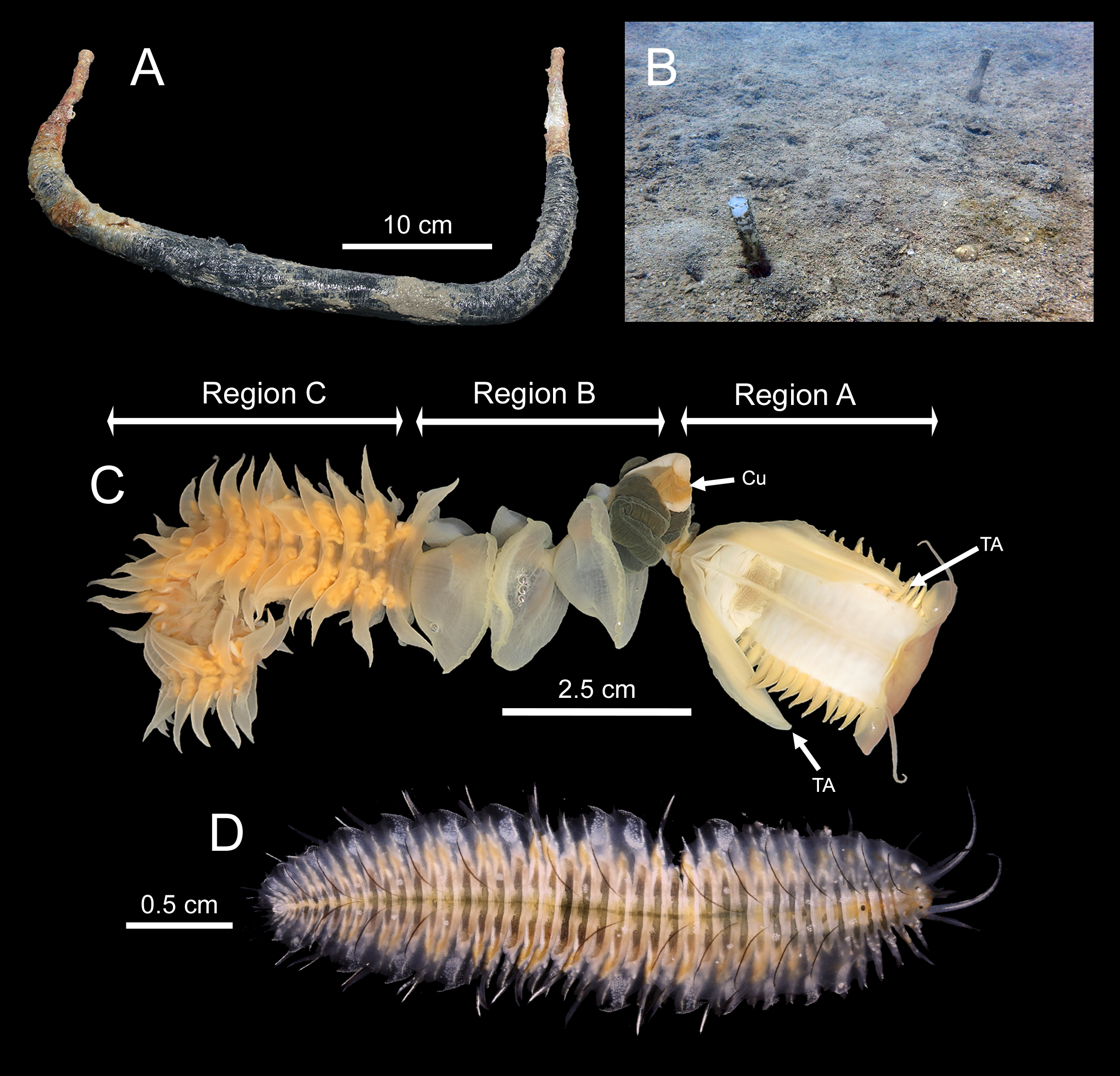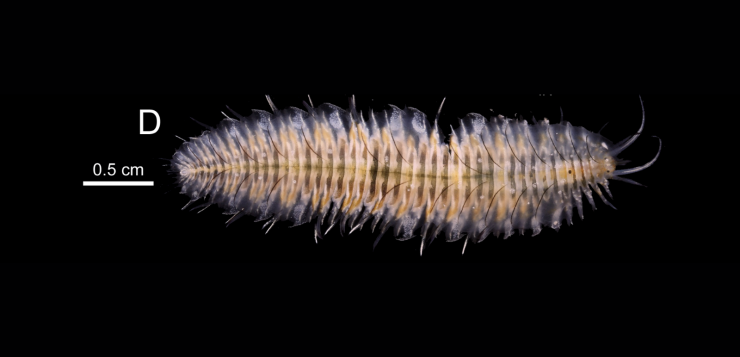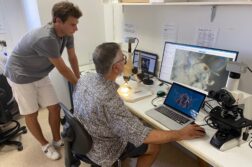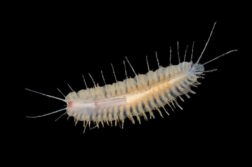Researchers from the Center for Advanced Studies of Blanes (CEAB-CSIC) and the Institute of Ecology and Evolution (IEE-RAS) of Moscow (Russia) have described for the first time the behavior of two marine organisms belonging to the polychaete group (marine worms): Ophthalmonoe pettibonae, in the role of symbiont, and Chaetopterus cf. appendiculatus, acting as a host. The results of the study, published in Scientific Reports, were based on observations and experiments conducted both in the field and in the laboratory.
The work, signed by Dr. Daniel Martin, from the CEAB–CSIC and Dr. Temir A. Britayev, from the IEE–RAS, reveals for the first time the existence of an extremely aggressive behavior in the symbionts, resulting in fierce contests to control the territory, in this case a host or, even in some cases, several hosts, which explains the uniform distribution (one symbiote in each host) observed in natural populations. It is an extremely complex symbiotic behavior for an apparently ‘simple’ animal, such as a marine worm.
They live together in the tube built by the host
Under natural conditions, both worms live together, buried about 20 cm deep in the marine sediment and inside the tube built by the Chaetopterus. This tube, which is made up of a mucilaginous substance that solidifies on contact with water acquiring the appearance of an aged parchment, can reach about 80 cm in length and 4 cm in diameter and has two openings (called siphons), which allow communication with water and measure only 1 cm in diameter.
For its part, the body of the Chaetopterus (the host) can reach up to 20 cm in length, while that of the Ophthalmonoe (the symbiont) barely reaches 4 cm. As the two scientists have observed, the symbiont locates one of the siphons thanks to the water current that the host continuously expels for breatheing and eating. Then, Ophthamonoe enters inside the tube and crwols towards the head of Chaetopterus, were it lays with the ventral side attached to the tube and the back facing the host body.

Very recently discovered in Indonesia and Vietnam
In 1997, Dr. Britayev already participated in the description of Ophthalmonoe as a new species, based on specimens found off the coast of Indonesia. In 2005, Britayev and Martin found for the first time the association between Ophthalmonoe and Chaetopterus in Vietnam and, in 2017, they studied the specificity of the association in the natural populations of that country, highlighting that Ophthalmonoe was always associated with the same species of Chaetopterus, even if there were others available nearby, and noting that they always found a single symbiote associated with each host.
In fact, symbiotic organisms are characterized by developing intimate and persistent associations with their hosts. For a symbiotic organism, hosts are vital resources providing protection against predators and environmental stress, but also oxygen, food, and space for mating or hatching larvae. Among marine invertebrates, worms often form symbiotic associations showing a wide variety of patterns of hosts use. However, most live alone with their host, probably as a result of territorial behavior. However, the role of territoriality in establishing these patterns remains poorly understood.
Experiments demonstrate a component of territoriality among symbionts
“The observations made in the populations of Vietnam led us to think that there must have been a territorial behavior between the symbionts, that they could even fight among themselves to maintain control of their host, since this represents a vital resource for their survival”, say the scientists.
The two scientists experimentally studied the influence of the ratio of the number of available hosts on the behavior of the symbionts. To do this, they transferred the host worms from their natural (opaque) tube to an artificial one made of transparent plastic that allowed them to observe what was happening inside.
The experiments show precisely the existence of an extremely aggressive behavior in the symbionts, which results in fierce contests to control the territory, in this case a host or, even in some cases, several hosts, which explains the uniform distribution (a symbiont per host) observed in natural populations.
In addition, their experiments showed that territorial contests to keep potential competitors away also occurred outside the host, which is the first empirical demonstration that a marine symbiotic invertebrate can control a territory extending beyond its own host, including other neighboring hosts.
Each fighting episode can include one to three attacks
Territorial attacks between specimens of Ophthalmonoe show a clear aggressive component, where the owner of the tube, after locating an intruder who intends to occupy the same tube and approach it protected by the host’s body, attacks it by means of a powerful evaginable trunk equipped with a pair of parrot-beak-shaped jaws. Both contestants united by the owner’s bite, curl one over the other for a long time, until the aggressor manages to separate a piece of the victim’s body. In fact, each fight episode (which can include between one and three attacks), ends up leading to bodily injuries.
“Sometimes both contestants show injuries”, say the scientists “since, if the intruder is larger, it can respond to the attack of the owner with another attack and forcing it to leave his own host”.
And it is that, apparently, Ophthalmonoe lacks the ritualized behavior that other symbiotic species (for example, crabs) have developed to reduce the risk of receiving injuries.
Vídeo 1. Sequence of a resident Ophthalmonoe pettiboneae attacking an intruder. The resident is always in the same position on the inner tube wall, except during the attacks.
Thus, the study provides the first empirical evidence that (1) the injuries of the symbionts were caused during territorial fights, and (2) the injuries found during the experiments were identical to those observed in natural conditions. Thus, the two scientists conclude that the presence of body injuries allows to predict the existence of intraspecific confronting in symbiotic polychaetes.
An excellent model for future studies on symbiotic relationships
The association between Ophthalmonoe pettiboneae and its host proved to be an amazing model for future studies on the symbiotic relationships involving marine invertebrates. However, the authors have identified multiple questions that remain open regarding the biology of the symbionts.
These include the function of their specialized eyes, which seemed to be useful for living inside the host tube, but also to detect their competitors and, possibly, their preys, or the importance of the processes of autonomy and regeneration in relation to the recovery from injuries received during the territorial contests, but also how these relatively isolated organisms can reproduce and what is their diet, where they get food and how they do it.
“Ophthalmonoe pettiboneae behaves like a highly specialized symbiont and seems perfectly adapted to living with its host,” says Dr. Temir A. Britayev, researcher at the IEE-RAS, and adds: “From the host, they obtain refuge, oxygen and, perhaps, food without harming or benefiting it, so that we may regard the association as an obligatory commensalism, close to an inquilinism.”
Dr. Daniel Martin, researcher at CEAB-CSIC, points out that “Our study represents the first description of such extremely complex symbiotic behavior in a polychaete annelid.”
Reference article:
Britayev, T. A. & Martin, D. (2021) Behavioral traits and territoriality in the symbiotic scaleworm Ophthalmonoe pettiboneae. Scientific Reports 11: 12408. https://doi.org/10.1038/s41598-021-91810-2




